The return of the czar
The return of the czar
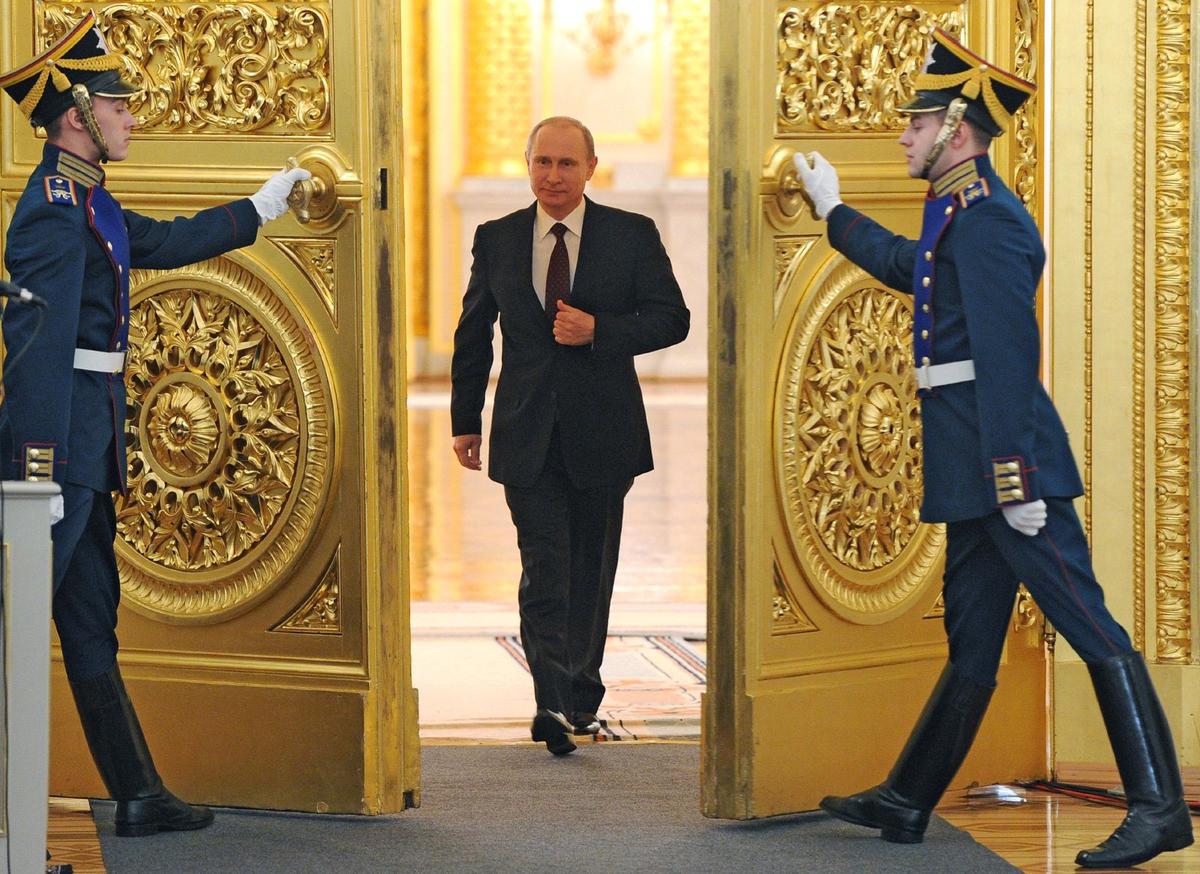
Russian President Vladimir Putin enters the St. George Hall at the Grand Kremlin Palace at the Kremlin in Moscow, on December 12, 2013, to deliver an annual state of the nation address. (Mikhail Klimentyev/AFP/Getty Images)
THE RETURN OF THE CZAR
One hundred years after the Russian Revolution,
an emboldened Putin regime is embracing its czarist past. Could 1917 happen again?
(Read this story in Russian here.)
Two Russian soldiers are posted on a mountaintop. One of them is looking through binoculars.
The first soldier asks the other, “Can you see Putin?”
“No, I can’t,” the second soldier shrugs.
“Nevertheless,” says the first soldier, “he exists.”
An old family friend named Olga is telling this joke as we walk along Litenyi Prospect in St. Petersburg in the starry glint of a Russian winter night. The traffic on the boulevards of 21st-century Putinstan is deafening—roaring buses, rambling trams, rusting Ladas, a Maybach here, a Bentley there—but in her mind’s memory, a child of the Soviet Union hears only her own small footsteps dashing up the solid stairs, Spokoynoy nochi, malyshi! (“Good Night, Little Ones!”) on the television, Babushka’s clucking hug.
“This is it,” Olga sighs, looking up. “Number 45.”
Granny Zinaida was a humble woman, her granddaughter says, who rose to the position of director of an institute of mathematics in this scarred old czarist capital after growing up along the bank of Mother Russia’s mightiest and most sacred river. Her daughter’s daughter, visiting there, literally became little Olga from the Volga. This was the Communist Manifesto made real: a descendant of unschooled peasants transformed into an educated Soviet citizen, preparing the next generation for their inevitable victory over the degenerate West.
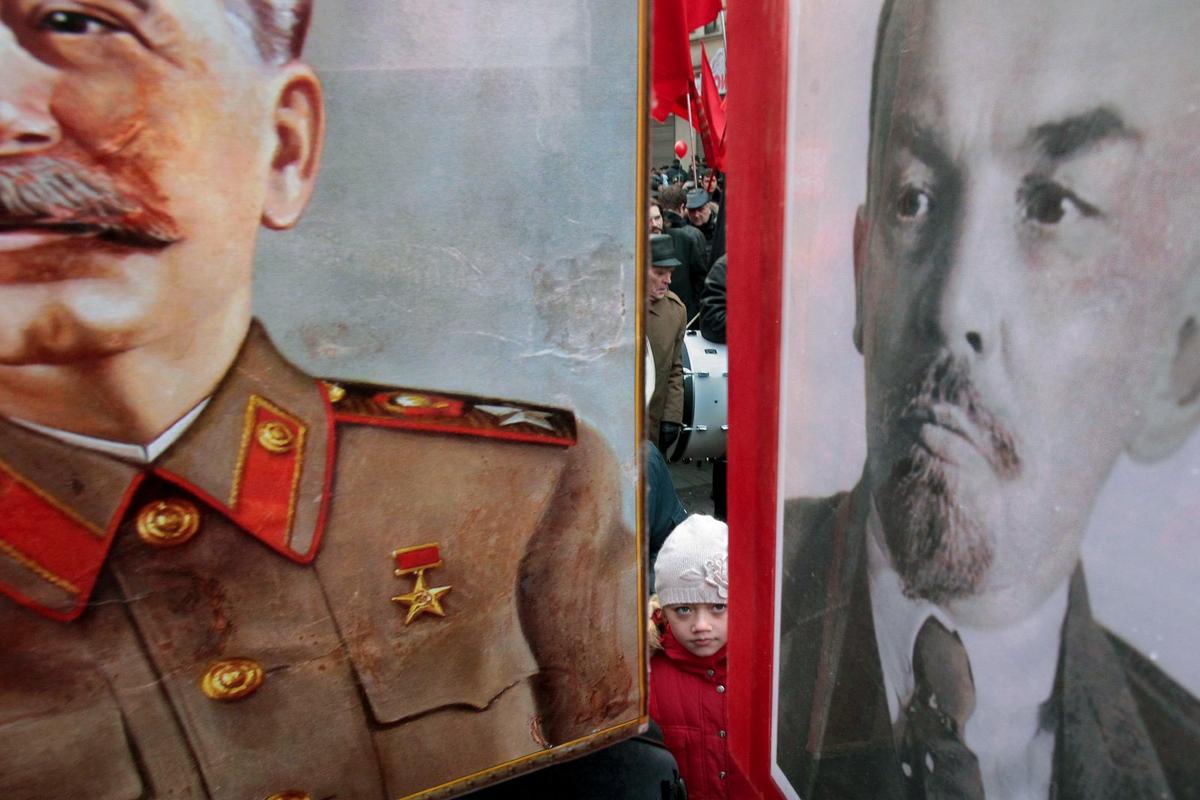
May Day demonstration in St.Petersburg, Russia. (Alexander Petrosyan)
In St. Petersburg, the river-woman and her husband—he had been plucked from a training institute for cinematographers and told that the Party needed him to drive a tank instead—shared one stove and a cold-water bath with seven other families at Litenyi 45. Zinaida died in 1989, a faithful marcher on the socialist road to the end. “We were so happy that she did not live to see everything she believed in become destroyed,” Olga smiles. The eight-family apartment, she says, is now a rich burgher’s pied-à-terre. St. Petersburg, whose paradisiacal pastel facades often hide musty decay within, is one of Europe’s greatest treasuries of art and architecture. And now, what began here a century ago—the abdication and murder of a God-empowered czar and the slaughter of his children; the red-flagged overthrow of the czar’s overthrowers; decades of civil war and a century of siege, invasion, repression, disintegration and upheaval—is returning to haunt the living and the consecrated dead.
It has been precisely 100 years since Nicholas II, czar of all the Russias, abdicated from the throne that his ancestors had held for three centuries, his palaces surrounded by citizens crying “There is no bread!” Condemned in Soviet textbooks as “Nicholas the Bloody,” a bumbler whose personal command of Russian troops in the First World War caused the senseless death of millions, the last czar has been revivified by the regime of Vladimir Putin as a nationalist paragon, and canonized by the Russian Orthodox Church as a martyr, passion-bearer, saint, a symbol of unity and love of the Russian folk.
Fifty years ago, the Communist behemoth swelled with statal optimism, even as the market shelves lay bare. At Expo 67 in Montreal, the USSR’s soaring, glass-walled pavilion boasted of how the Soviet state was exploiting the resources of land, sea and sky “in the name of man, for the good of man.”
Fifty years later, National Geographic calls the state of the Russian soul “a hapless search for a uniting idea.” In place of Nicholas the Bloody, the Russian nation has repeatedly chosen Vladimir the Barebreasted—seizer of enclaves, annihilator of opponents, hacker of emails, hater of Hillary, fan (real or feigned) of U.S. President Donald Trump. If you’ve got the rubles, there is no shortage of bread. Or Bentleys.
It is at this moment that Russia and its president must address the legacy of 1917—the throngs in the streets waving red banners, dragging the emperor from his throne and pumping slugs into him and his kids. “The upcoming centennial of the 1917 revolution that toppled the czar and paved the way for Bolshevik rule promises to put the Kremlin in a tight spot,” predicts the (still-) independent Moscow Times. “At the same time, the Kremlin is unwilling to unequivocally condemn the events the revolution set in motion or its Soviet past.”
So a visitor travelling from St. Petersburg to the edge of Siberia and to Moscow wonders: how do Russians view their own revolutionary past, a century later? And, more relevant: could 1917 happen again in a renascent age of one-man rule?
“Here’s another one,” says Olga. Putin walks into the canteen at the State Duma with three other politicians: Mironov, Gryzlov and Volodin.
“I’ll have the steak,” Putin says.
“And vegetables?” asks the waitress.
“They’ll have the steak as well.”
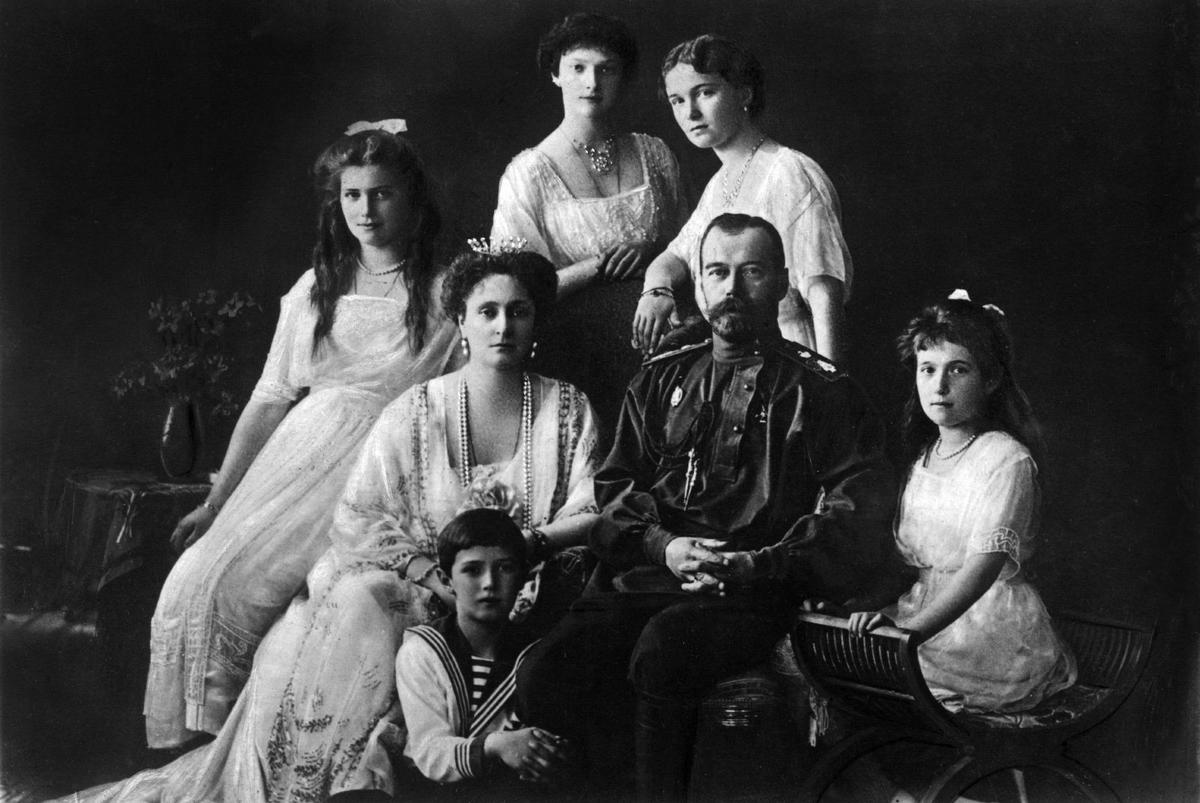
Czar Nicholas II of Russia with his family. (Mondadori Portfolio/Getty Images)
The Rembrandt Room at the Hermitage State Museum, the world’s greatest repository of art.
Guide Yelena Soromakha has been working here for 37 years. The joint is infested with masterpieces; right next door is a harem of gambolling Rubens nudes.
“Russia today is a presidential republic,” Soromakha is saying, pausing in front of Rembrandt’s Return of the Prodigal Son. “So far, I don’t see anyone who could compete with Putin, and I’m not saying that because I like Putin.”
“Russia is a big country. It is very hard to organize. Perhaps we need a different kind of organizational structure, but so far we have known only two: empire and dictatorship.”
We slide into the Winter Palace, in 1917 the hovel of the doomed dynasty. Legions of Chinese swarm the corridors, their ennui reflected in porcelain and malachite.
“The end of the Romanovs was absolutely terrible,” Soromakha says. “They didn’t know they were going to be executed. They thought they would be only evacuated. The plan was for each soldier to shoot only certain people, but they all started shooting Nicholas instead. Little Prince Alexei was seated in his chair, and his sisters gathered around him to protect him. “The little prince was killed with bayonets.”
We enter the room where the cabinet of Alexander Kerensky, the small-d democrat who took control of the government after Nicholas packed it in, was meeting when, according to a Soviet-era plaque still on display, “Red Guards, soldiers and sailors stormed the Winter Palace and arrested the counter-revolutionary bourgeois temporary government.” Lenin took power a few days later. The palace was turned into an orphanage, a school for cavalry officers and a movie theatre. Kerensky wound up as a professor at Stanford.
From the window, we can see the monumental archway through which—signalled by a cannon blast from the cruiser Aurora in the Neva River—the vanguard of the Bolsheviks swarmed a century ago. “This was the end of Russian democracy,” Soromakha says. “It happens all the time. People have good expectations and they don’t turn out.”
“The end of Russian democracy forever?” she is asked. She wiggles her hand.
“Compared to Stalin’s time, what we have now is democracy,” she says.
On board the Aurora, which has been preserved as a floating museum, one treads the same boards that have been walked by Nicholas the Bloody and Putin in their turn. A dozen junior officers are studying exhibits pertaining to the ship’s illustrious career.
“Is it time for another revolution?” a visitor asks one of the seamen, rather cheekily.
“Well, it has been 100 years,” he replies.
“Is it good to have a revolution every 100 years?”
“In this country, maybe even more often,” says the naval officer.
A yellow taxi en route to the campus of St. Petersburg State University.
“I don’t have a lot of information about Trump, but I hate Hillary Clinton on an organic level,” the driver is saying. “What I don’t understand is why, when half of the people vote for one candidate, the other half do not accept the results. Trump was the candidate of the working people—not just those who work in factories, but those who actually work. Clinton was the candidate of people who receive. And of a lot of big black people who play basketball.”
“Is Putin the new Czar Vladimir the Great?” the hackie is asked.
“I think rather not,” he answers. “The powers of the president are limited. But he will serve until he is dead. Or until he gets shot by his ‘friends.’ ”
On the sixth floor at St. Pete State await the distinguished professors Sergei Korkonosenko, head of the department of journalism and mass communications, and Gennady Zhirkov.
“I was recently at Tsarskoye Selo,” (“Czar’s Village,” the Romanovs’ bucolic retreat) Korkonosenko reports, “and the guide was standing by a portrait of Nicholas II and repeating all the stereotypes: ‘He was very kind. He loved his children. They cleared the snow around the palace themselves.’ There is a war on, the empire is crumbling, and he’s shovelling snow?”
“Is it possible that we could overthrow the current regime?” Korkonosenko muses. “In order to answer that question, we need to know: what are the prerequisites of any revolution? One, the current leader would have to be one whom the people of Russia do not accept. However, his approval ratings are quite high. Two, there would have to be fighting within the elites, but we don’t see that right now, either. Putin’s party will stay in power in the next election. And three, there could be a political disaster such as Nicholas faced in the First World War. But right now, Russia acts as a winner!”
There is another crucial difference between 1917 and 2017, Korkonosenko notes: “The emperor’s power was derived from the myth of divine origin. Our current president’s power does not come from God.”
“There are two circumstances that must be considered,” says his colleague Zhirkov. “Russia is a vast territory, which means there must be a centralized power. Otherwise, all the outer territories will scatter. The second is that Europe has always been suspicious of Russia. So there is a tendency to resist this through autocratic power. The trend toward dictatorship is possible, and that continues today.”
“Your people should be happy,” says Korkonosenko to this American-born reporter. “You’ve never had a dictatorship. And you’re afraid of Trump?”
Behind the educators is a large wall map of Mother Russia and its vassal neighbours. Abkhazia and South Ossetia, two tiny fragments of the post-Soviet Republic of Georgia that were liberated by Putin by blitzkrieg in 2008 stand out in crimson like kidney beans. But Crimea, seized three summers ago, remains as pink as the rest of Ukraine.
“Why isn’t Crimea shown as an integral part of Russia?” one wonders.
“The government does not give us money for a new map every time the map changes,” the distinguished professor says, smiling.
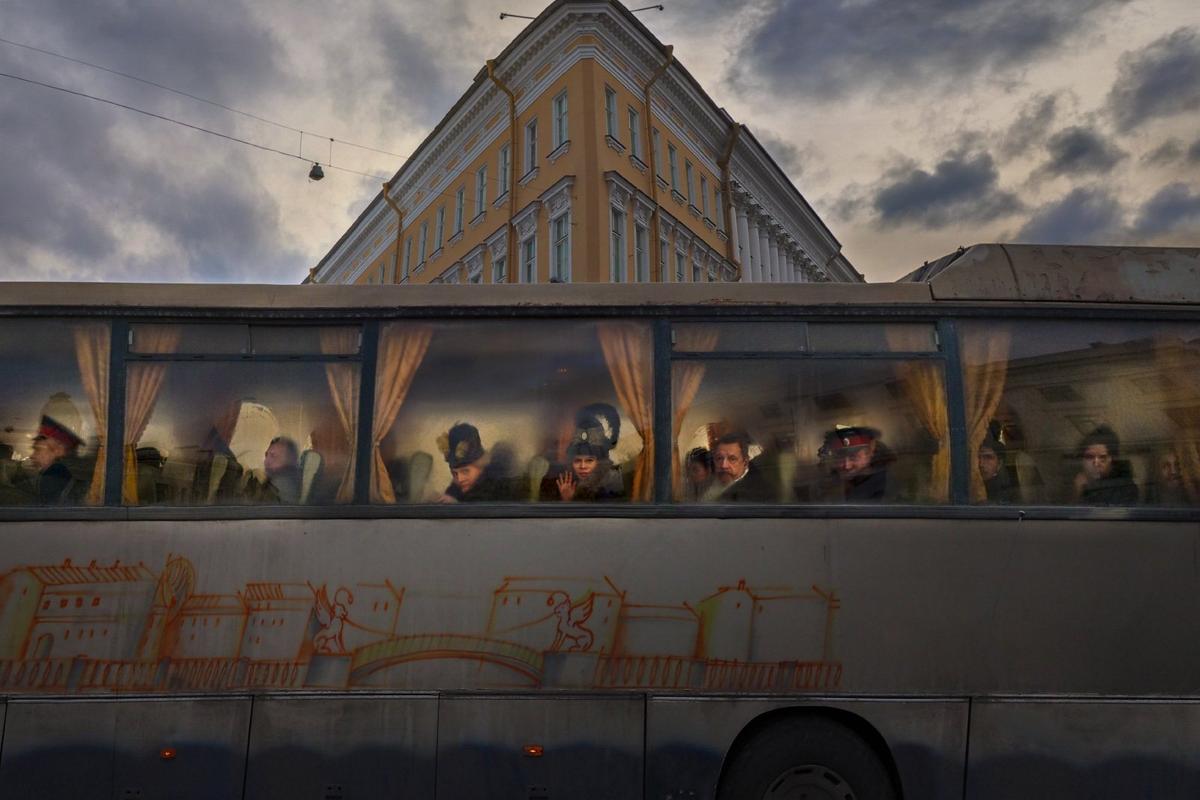
Bus filled with actors while filming in St. Petersburg, Russia, February 2017. (Alexander Petrosyn)
A musty apartment across town, filled with ancient tomes, an old piano and leather suitcases.
Fyodor Dostoyevsky the fourth comes hurtling into the room.
Dostoyevsky is six years old. He proudly, loudly counts to 10 in English and vaults into his grandfather’s lap. The grandfather is Dimitri Dostoyevsky, former streetcar driver, gem cutter and laboratory worker, and, in his 70s, the eager heir to the great writer’s legacy. Who would come to St. Petersburg and not want to meet a real Dostoyevsky?
“I am a monarchist,” Dmitri says. “I have now come to understand that monarchic autocracy is the best way for Russia—and I mean without parliament! That is why I do not accept either the February Revolution or the October Revolution. I am a descendant of nobility on both sides. The czar is the father of us all.”
Dmitri Dostoyevsky has met Putin. “I looked into his eyes,” he says, reprising George W. Bush’s famous gaze, “and I saw a very nice tone. But I did not see a czar. The czar was prepared from birth for his role. Putin was KGB.”
“None of my monarchist friends perceive Putin as a monarch, although the instinctive feeling of Russians might be to see him in that way. As was said, ‘In heaven, God. On Earth, the czar.’ So far, Russia does not reject him. He gets high ratings. After our previous leaders, he looks good. In 2018, I personally will vote for Vladimir Putin.”
Recently, there was that other election across the pond.
“Sometimes, I couldn’t tell if it was we who were choosing between Clinton and Trump or if it was the Americans,” says Dostoyevsky. “Our TV was showing nothing but that from morning to night. We knew Clinton from before. We never could have gotten along with her. I am a monarchist. I am a conservative. I would have voted for Trump.”
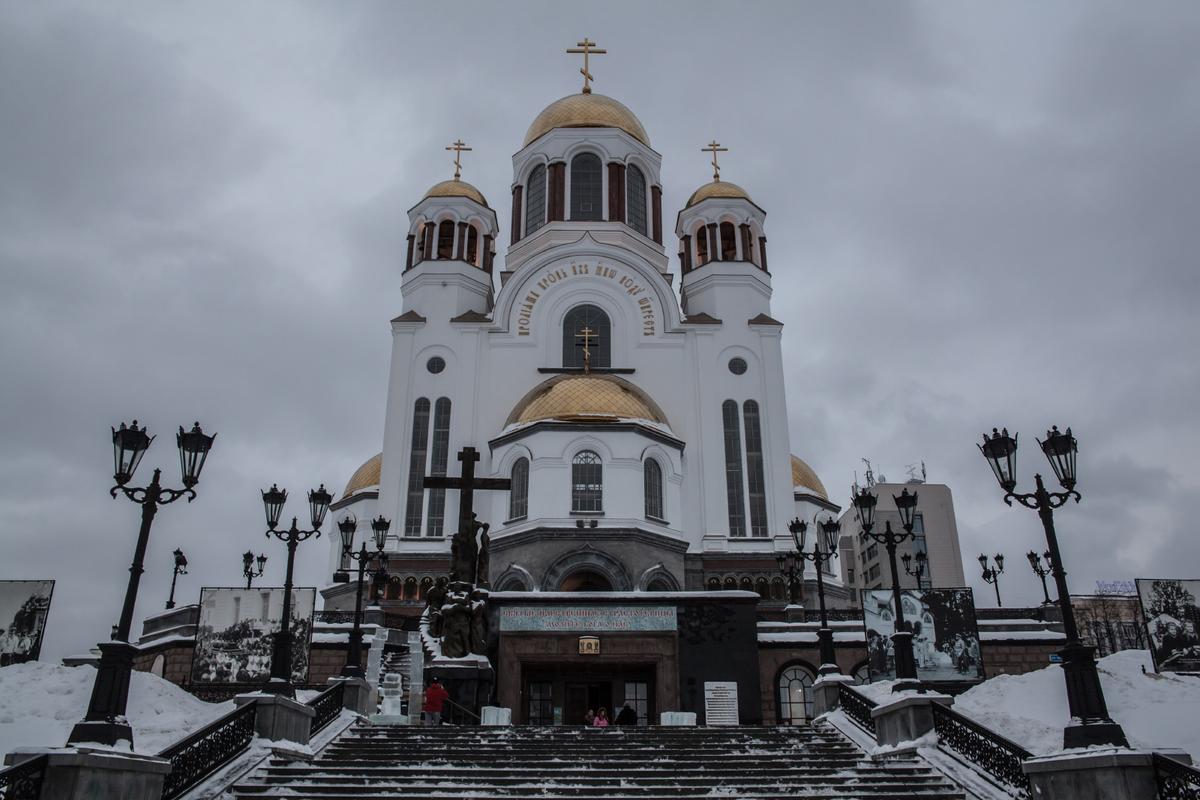
The Church on the Blood in Yekaterinburg, Russia. (Antonino Savojardo)
“We Russians are afraid to look to the future,” Anton the IT guy is saying in the basement of the church.
Reverent chanting is coming from the chapel; a choir of angelic sopranos softly trills. It is the Church on the Blood in the Name of All Saints Resplendent in the Russian Land, in the city of Yekaterinburg, in a wide pass through the Ural Mountains, on the western verge of Siberia. Yekaterinburg is the fourth-biggest metropolis in the world’s largest country, a surprisingly appealing riverside city of museums, memorials and ultra-modern glass-and-steel skyscrapers, not to mention the titanic smokestacks of one of the largest heavy-machinery factories on Earth. There are minerals and money here.
Outside the church, the temperature is minus 31 degrees Celsius. Inside, a long skein of bundled worshippers pad toward the altar, which has received, for temporary display, an icon of the Holy Virgin from Kiev, 2,000 km to the west.
“We’re afraid of the future, so we look to the past,” our companion says. “There are only two dates that we can all agree on: May 9, 1945, and April 12, 1961.” These were the surrender of Nazi Germany and the launch of cosmonaut Yuri Gagarin. “We are still searching for our national idea,” says Anton.
The Church on the Blood in the Name of All Saints Resplendent in the Russian Land is a whitewashed cathedral with golden onion-domes that was erected in the 1990s on the site of the mining engineer’s mansion where Czar Nicholas II, Czarina Alexandra, Czarevich Alexei and Princesses Tatiana, Olga, Maria and Anastasia were massacred by Bolshevik gunmen on a summer midnight during the Red-White civil war, having been trundled to the Urals for safekeeping.
It was July 17, 1918. At the gold-domed church, icons of the royal seven receive their own adoration. (“The worshipping began since the day of their martyrdom, though hidden as persecuted by the regime,” notes the guidebook.)
“This is not a religious building,” Anton sniffs. “This is a political monument. If people want to go to church, there are many other churches.”
A gigantic prelate in jet-black robes erupts into a meeting room: Father Maxim. He is a former super-heavyweight karate champion who believes that Nicholas II “was one of the greatest sovereigns of our century, maybe the greatest one; an example for the world.”
“The first revolutionary was the Devil,” Father Maxim says. The events of 1917, he avows (he is not alone in this) were instigated not by a lack of bread in the shops of St. Petersburg but by the mendacious intervention of the British ambassador. Just as many Americans espy the evil hand of Russia in the 2016 election results, many Russians believe, as Father Maxim puts it, that “the aim of the West is one—to weaken Russia.”
“The main plus of monarchy is that it is impossible to influence power with money,” he says.
“Is Russia a Christian nation today?” he is asked.
“Pity, no,” he answers. But he asserts that, in Putin’s domain, “the level of freedom is higher than in Finland or Germany.”
“But does Putin have the power to take away that freedom?” one wonders.
“It doesn’t just depend on Putin, as you believe in the West,” says the Orthodox priest. “Anyone who says this does not understand the nature of freedom. The real freedom is inside us. It only depends on how much we are enslaved by sin.”
After they were shot and bayoneted in the basement of the house that stood where the Church on the Blood now has risen, the remains of the Romanovs were removed by truck in the middle of the night to an abandoned mine shaft 20 km outside Yekaterinburg. There, in the immemorial Russian forest of birch and pine, they were doused with acid, set on fire and heaved into a pit.
At the same haunted site now—it is called Ganina Yama—a pious local industrialist has donated enough money for the construction of seven separate chapels, one for each of the martyred royals, and a monastery to prepare the next generation of Father Maxims.
Each July 17, more than 50,000 pilgrims walk overnight from the Church on the Blood to Ganina Yama to recapitulate the Romanovs’ final journey. This, also, is 21st-century Russia; it is not just hacking John Podesta and riding horses shirtless.
A woman named Yelena Kostina leads us around the site. In school, she says, “we knew the czar only as Nicholas the Bloody, and we were taught that the empire was on the verge of collapse because of the Romanovs’ misrule. But now I have a great pity in my heart because of what happened to that family, and what happened to my country. I feel pity to the Reds and the Whites, to all sides, because there is no right or wrong, only the will of God.”
Thirty years ago-—“at a time when we could talk of God only in our kitchens”—Yelena’s five-year-old son became ill with meningitis. She remembered the 11-year-old hemophiliac Czarevich Alexei, who was provided a chair and a pillow to sit on in the execution chamber. “I looked into my son’s eyes—as if into Prince Alexei’s eyes—and I saw the eyes of death,” she says. “That is when I became a Christian.”
Her son recovered.
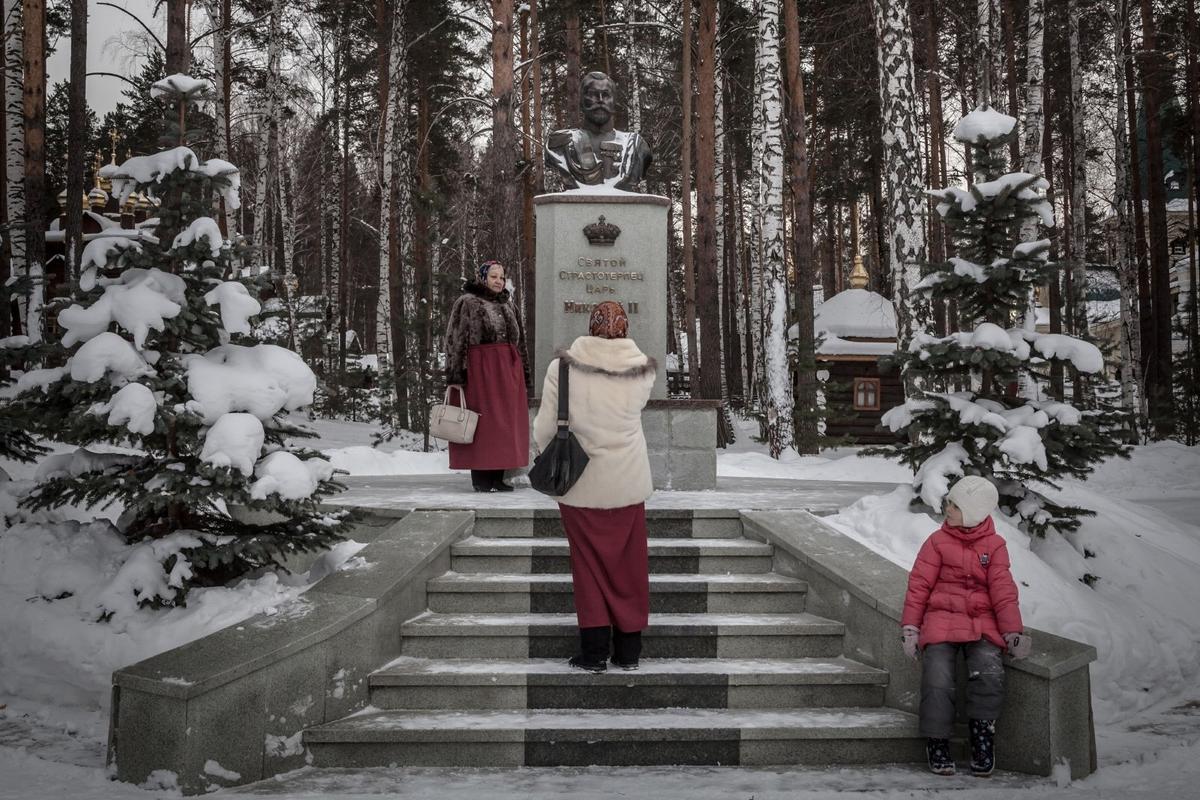
Pilgrims visit a statue of Czar Nicholas II at the Ganina Yama monastery. (Antonino Savojardo)
In the modern Russian consciousness, the city of Yekaterinburg is associated with seven martyrs—the royal Romanovs—and one pariah: Boris Yeltsin. This is the hometown of the bulbous, bibulous, white-haired ex-Communist who became, after a fashion, Russia’s first authentic, democratically elected chief executive, and who, failing physically at the dawn of the new century, bestowed the presidency upon Putin with the fateful, plaintive moan, “Take care of Russia.”
It was Yeltsin, as Party chief of Yekaterinburg, who fulfilled Moscow’s orders to demolish the Romanov death house. It was Yeltsin who stared down the gun-barrels of his opponents during a coup attempt in 1991. It is Yeltsin whom most Russians still blame for the economic catastrophe of the ’90s. And it is Yeltsin whose deconstruction of the USSR itself is what Olga from the Volga is thankful her red-eyed grandmother did not live to see. (Putin has called it “the greatest geopolitical catastrophe of the 20th century.”)
Now, on the bank of the frozen Iset River, suddenly: the brand-new Boris Yeltsin Presidential Museum, the first (and so far only) such edifice in the country, designed by the folks who erected Bill Clinton’s museum and library in Little Rock, Ark., and jammed, on a midwinter Saturday, with thousands of Russians old and young, almost all of whom hate the late Yeltsin like a dog hates cats.
“Some people adore that time,” says the museum’s 33-year-old architect and deputy executive director, Dmitri Pushmin. “But most people reject it. We should try to explain what those times were. The new Russia is not the czarist Russian empire. It is not Soviet Russia. It is a new state, and Boris Yeltsin established it.”
The museum offers an absolutely stunning—if one-sided—elaboration of the collapse of the moribund, malevolent USSR, with the native son at the centre of events. The galleries wind through the political, economic and social upheavals of Yeltsin’s presidency—the brutal war in Chechnya; the legalization of rock ’n’ roll—and deposit a visitor into a chamber called the Hall of Freedoms.
“Russia is completely different now compared to 1987,” Pushmin says. “We have a constitution. We have a legislature. We have freedom of enterprise. We can travel abroad. We have elections with a choice of several different candidates. Thirty-five years ago, we had only one name on the ballot. In 2018, there will be several.”
But only one of those names, of course, will win. “Are these freedoms under attack by Vladimir Putin?” the architect is asked.
“Sometimes, of course they are,” he replies.
A few months ago, the prominent film director Nikita Michalkov charged that the Yeltsin museum, with its promotion of so-called “freedoms,” was injecting “poison” into the veins of Russia’s children and facilitating the “collapse of the country,” an event that “is the dream of the world community.”
A Muslim leader named Ismail Berdiyev, a key figure in President Putin’s outreach to minorities, went a step further and suggested that the museum “be blown to hell.”
“When people say that your museum should be blown up, how do you respond?” architect Pushmin is asked.
“When people say something like that,” he sighs, “they are using the freedom they were granted in the ’90s.”
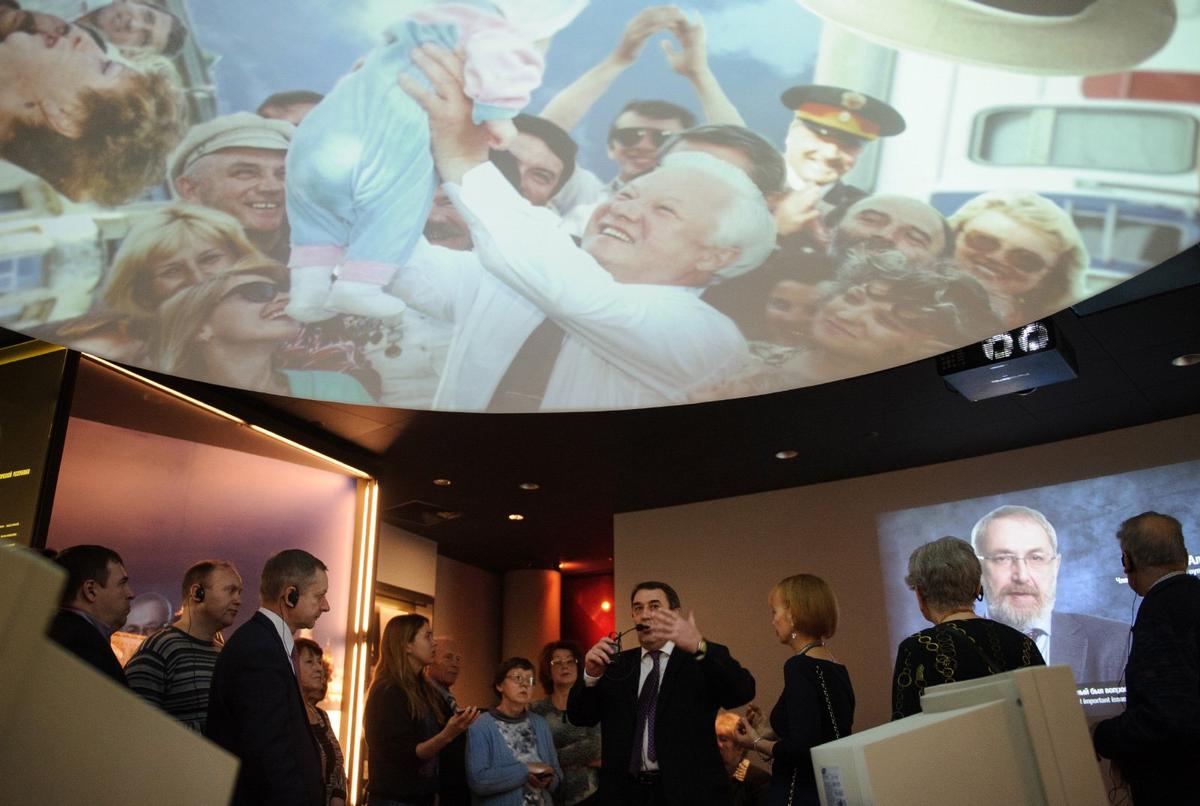
Former Russian economy minister Andrei Nechayev (centre) gives a tour at the Boris Yeltsin Presidential Centre. (Donat Sorokin/TASS/Getty Images)
In 2014, Mikhail Zygar, the thirtysomething editor of TV Rain, the last surviving independent television network in Putin’s Russia, received the International Press Freedom Award from the Committee to Protect Journalists. By then, he had emerged as a truth-teller in a swamp of alternative facts, presaging the role that honest reporters would soon play in Donald Trump’s White House.
By then, alas (and of course) TV Rain had been dumped—on the orders of guess who?—from every cable provider in the country and had been prohibited from selling advertising.
“That cost us 90 per cent of our audience in one day,” Zygar says now at a fashionable café across the street from the Moscow Circus. He has forsaken TV Rain for a seemingly less tendentious project—the centennial of the Russian Revolution—more correctly, the Revolutions—which he is chronicling online at Project1917.com from original letters, diaries, books and newspaper dispatches, all of them unfiltered through the charcoal of modern politics.
“In Russia, all history is politicized, all history is propagandized; it only tells us that the figure of the ruler is sacred,” Zygar says. “The history of 1917 needs to be known. The tragedy of 1917 needs to be known. People think that our history was only the history of czars, rulers and presidents. People think that the 19th century was just a series of numbers: Alexander the First, Alexander the Second, Nicholas the First, Alexander the Third, and that civil society cannot change anything.”
So there is a subliminal method to this centennial data dump—that the people do have power; that the overthrow of Nicholas II was not, “as the official version has it, that the February Revolution was paid for by the British and the October Revolution was paid for by the Germans,” says Zygar. “The truth is, the February Revolution was a true revolution, and the October Revolution was made by a gang of terrorists.”
“Aren’t you dancing around saying that it is time for another true revolution?” Zygar is asked.
“No no no no no!” he retorts. “I’ve already been labelled the ‘head of the opposition TV channel’—I don’t have to dance around anything. This project is not about ‘Look, little children, Putin is a czar and we need to repeat 1917.’ ”
Donald Trump, Zygar says, gives the Russian government precisely what they crave—immoral equivalence. “They feel that those Western politicians who used to lecture us about human rights are cheaters,” he says of the Putinists. “They prefer pragmatic guys who don’t pretend to be saints. When Trump said, ‘Do you think our country’s so innocent?’ Putin couldn’t have said it better himself. Soviet propaganda used to be: ‘We are right and they are wrong.’ Today, it is: ‘We are all bastards. Our elections are rigged, and their elections are rigged. Our cops are bad, but their police kill innocent black people.’ ”
Putin was president of Russia when 2017 began. He will be president of Russia when 2017 ends. “At present, the regime is authoritarian,” says Yegor Isaev, a lecturer at the Moscow School of Social and Economic Sciences at yet another trendy tea shoppe near the Kremlin walls. “But in 2035, that regime might change.”
“Right now,” Isaev says, “there is an overwhelming fear of the country falling apart, a fear that goes back to Yeltsin’s time, to the 1990s, when the country did fall apart. That’s why it is still so difficult to talk about 1917, because that was a time of division, and the government needs to present a narrative that unites the nation.”
“Hush… hush… tomorrow is a new day,” the hostess would coo to close each episode of Good Night Little Ones on the little television in Olga’s grandmother’s apartment on Litenyi Prospect.
And so it is with the rising generations of Putin’s Russia, a century after a god-given czar was dethroned, and buried and burned.
“I understand that talking to power in the streets is impossible today,” Isaev says. And so the malyshi wait for their hour to come.
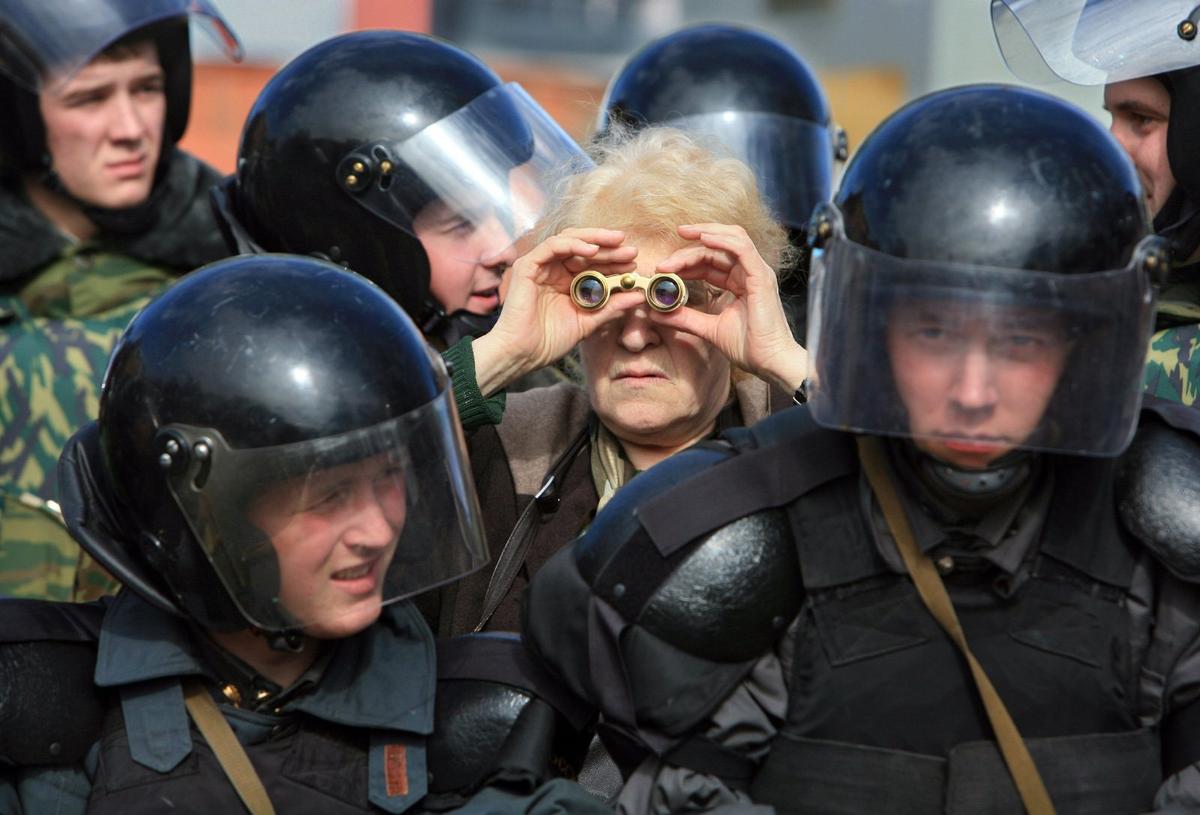
March of Dissent in St. Petersburg, Russia, April 2007. (Alexander Petrosyan)
There is one final question, to be asked of one of modern Russia’s most revered and irreverent writers—the playwright and historian Edvard Radzinsky. We are in his flat in an old Soviet housing bloc in uptown Moscow, a spacious warren overladen with books—many of them written by him—whose parquet floors have not been polished in many, many years.
At 80, Radzinsky, who once had nine of his plays being staged in Moscow at the same time, bursts with fervour, arms waving, dyed hair flying, so short of time. He talks of how Putin “wears a czar’s clothing,” how the weakness of Barack Obama emboldened the Russian autocrat, how “today, it is useless to speak the truth in either of our countries.”
This stops the reverie. A visitor asks, “Why did they have to shoot the children?”
When Yeltsin opened the secret Soviet archives in 1991, Radzinsky was the first outsider in more than 70 years to see the Yekaterinburg files. “It was fantastical, incredible; that night came alive in my eyes,” he remembers.
“Why did they have to shoot the children?”
To answer this, he quotes from Dostoyevsky—not the streetcar driver or the six-year-old, but from The Brothers Karamazov. There is a passage, he says, in which one brother asks the other if he would torture a single child to ensure a happier world.
This is the paragraph:
“Imagine that you are creating a fabric of human destiny with the object of making men happy in the end, giving them peace and rest at last, but that it was essential and inevitable to torture to death only one tiny creature—that baby beating its breast with its fist, for instance—and to found that edifice on its unavenged tears, would you consent to be the architect on those conditions? Tell me, and tell the truth. ‘No, I wouldn’t consent,’ said Alyosha softly.”
“To this question,” Radzinsky says, “the Bolsheviks answered yes.”
He closes his eyes and sees the little Prince Alexei on his pillow, in his chair. “When the girls rush to protect him, trying to stop the bullets with their hands, this was a vision of the concentration camps, of all the horrors to come,” he says. “Everything that is built on blood is built on sand, and when the wind starts blowing, the building will fall, as it is said in the Bible. I wrote that myself in the ’70s—this building will fall. And it did.
“Do not focus on ‘Putin is so strong.’ Stalin was stronger. In Russia, you need to live a long life. Whatever is happening, it is only the beginning.”
Reporter: Allen Abel
Editors: Alison Uncles, Colin Campbell
Art director: Stephen Gregory
Director of Photography: Liz Sullivan
Contributing photo editor: Sarah Palmer
Digital producers: Adrian Lee and Nick Taylor-Vaisey
Published: March 7, 2017